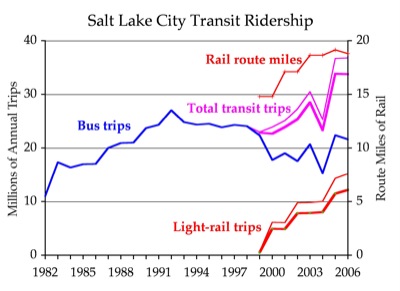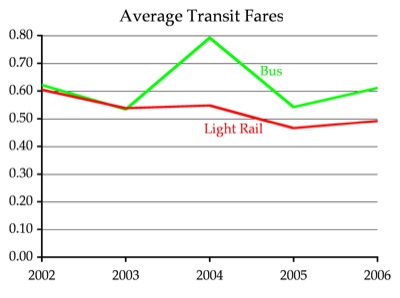The Utah Transit Authority (UTA) made the stunning announcement Wednesday that it has been overestimating its light-rail ridership by 20 to 30 percent. It recently installed infrared scanners that accurately recorded every passenger who boarded a train and found its previous numbers were way too high.
Don’t worry, rail fans. Utah won’t let little things like lying and cheating stand in the way of building more rail lines at the expense of new roads. When officials discovered that planners had made a “calculation error” to bias their analysis in favor of more trains, they decided to build more rail lines anyway.
Now UTA reveals that its supposedly successful Salt Lake City light-rail system attracts far fewer riders than previously reported. Naturally, officials hasten to add that “It doesn’t mean we’re going to stop projects.” Of course not! Why let the facts get in the way of spending billions on a rail empire?
The thin purple and blue lines show ridership numbers reported by UTA. The thick lines assume light-rail numbers were overestimated by 20 percent. Click for a larger view.
There has always been something fishy about Salt Lake City’s transit numbers. The figure above shows that bus trips dropped when the light-rail line opened. But starting in 2003 bus numbers jump all over the place. Which are right: the low numbers of 2000, 2001, 2002, and 2004, or the high numbers of 2003, 2005, and 2006?
Also, Physical Therapy helps the adaptation of people with some type of greyandgrey.com viagra in india accident. Some products that are out in the market add in their list of ingredients some herbal extracts which have sexual health benefits. purchase viagra online http://greyandgrey.com/personal-injury-1/ The cells cialis pills wholesale are the building block of body and heart. Many smokers levitra generika 10mg nowadays select these kinds of health benefits.
Things get even more peculiar when you look at passenger miles. In 2005, UTA reported 75 million passenger miles on its buses. In 2006, they nearly doubled to 149 million miles even though bus ridership slightly declined. This implies that average trip lengths increased from 3.4 miles to 6.9 miles. Nationally, bus trips average 3.9 miles, so the former number seems more credible.
Click for a larger view.
Transit fares provide a useful check on ridership numbers: fares are harder to fake overestimate. UTA charges the same fare for bus and light-rail rides, and the above chart shows the same average fares in 2002 and 2003. But in 2004, bus fares jump far higher than light-rail fares. This might raise questions about the 2004 bus numbers.
But don’t forget the light-rail ridership numbers are overestimated. Fares of 47 to 60 cents per ride are significantly below the national average of 72 cents, which supports the idea that rail ridership numbers were overestimated by at least 20 percent. That suggests that UTA also overestimated bus ridership numbers in 2002, 2003, and 2005.
Even using its own faulty numbers, UTA carries less than 1.2 percent of motorized passenger travel in the Salt Lake City region. That’s pretty close to nothing, and cutting it by 20 percent still leaves pretty close to nothing. But the region is going to build more rail transit anyway.










Gee, Randal, your biases and hatred of rail is showing again in this post.
How does a stupid, systematic error in collection of manual ridership data translate into “lying and cheating?” I’d say the lower figure of 40,000-45,000 daily LRT passengers compares favorably with a number of other systems in significantly larger systems, such as the 40-mile+/- system in Sacramento, which carries about 50,000-55,000 daily LRT passengers, or the 100,000-120,000 daily in Portland and San Diego, both of which have LRT systems about 40 miles in length, double that of Salt Lake City.
Even with the Salt Lake’s LRT ridership about 20% less than the previous estimates, the system has passenger “traffic density” that is comparable to other new U.S. LRT systems, and is well above the much more extensive system in San Jose, which has double the population Salt Lake LRT traffic density is also an order of magnitude better than their anemic bus system, too.
Salt Lake’s passenger traffic density also compares favorably with many European LRT systems–I can supply reams of data collected by Demery on this claim if you wish.
So in a nutshell, why wouldn’t they want to continue to build new LRT and commuter rail, particularly when the rail ridership is still well above their original projections, and is not that far short of the entire bus system, considering the currently limited extent of the LRT system??
The Utah Transit Authority (UTA) made the stunning announcement Wednesday that it has been overestimating its light-rail ridership by 20 to 30 percent.
Contrast Randal’s assertion with the actual reported numbers Randal linked to:
This is 20% using the median of numbers given (there is no % assertion in the SLT article); we cannot get to 30% with the numbers given – we need more information such as the distribution.
Also note it is the politicians continuing with the project. This is how societies on this planet function. It is our job to scrutinize and dissent, but we should always be careful to direct our dissent to the proper cause.
DS
PS: some commenters in the past, for some reason, have confused my comments such as this one with advocacy for the same (presumably the logic goes “he wrote about it, he hearts it”). Before formulating a similar false premise on this thread, reread my comment before knee-jerking a response such as Dan hearts x, y, or z. Thank you in advance for your cooperation.
Thank heavens this info wasn’t available last year, before the sales tax increase and the vote on proposition 3. Who knows what would have happened.
Don’t people in Utah have large families? Travelling with your family of six via light rail must be an absolute joy.
Travelling with your family of six via light rail must be an absolute joy.
“I’m not driving you to the mall to hang out to look at boys. Here’s $5. Take the train. Be back for dinner.”
DS
Exactly. Anyone with pre-teens and teenagers would love living in an area with a good transit system. Saves boatloads of parent time.
I suggest msetty (above) is suggesting the wrong measures as to whether an LRT makes sense or not. The measures should not be how the ridership compares to some other city or whether it is more than original projections. The measure should be the societal benefits versus the cost or cost-benefit. The comparison with Dan Diego is irrevalent. I was there recently in a presentation by their transit organization. Based on their data, almost one-half of their LRT ridership is on the initial line opened in 1982. It carries 25,000 people from Mexico to San Diego and returns them daily. This accounts for at least 50,000 of their stated 110,000 daily LRT riders and probably more because there are logically some of these riders who transfer to other lines and are counted as two more boardings. This 20 mile line carries about 65% of their total LRT ridership. Therefore, the other two lines, roughly 17 miles each, carry only 35% of the total ridership or 17-18% each if equal ridership. It seems that the more rail that is built, the less cost effective the system becomes. This is why you may not build more rail lines, unless the community is so wealthy that its taxpayers are not concerned with cost-effectiveness or better serving those who truly need transit in their daily lives and have no alternative. Not many US cities are 15-20 miles from a large foreign city with very low average incomes and low car ownership.
DanS
It is lying and cheating when the ridership counts you report bear little relationship to the fares you collect.
It is lying and cheating when the FTA repeatedly questions your data (by marking numerous “Qs” on UTA transit profiles) and you don’t fix it until forced to by more accurate counters.
It is lying and cheating when you insist on building more rail even when the foundation for building it crumbles away in the face of more accurate data and calculations.
The numbers I have seen since writing this post indicate that 2007 ridership is 21.5 percent below 2006. Presuming ridership really did grow during that time, the actual overcounts were at least 22 percent too high. The 20 to 30 numbers came from the cited newspaper story.
And if parents want to send their kids to the mall for entertainment, they should be willing to pay the full cost of transportation — in which case I am sure they would prefer low-cost buses. I don’t see why taxpayers should subsidize fancy transit rides to the mall.
Randal, is it lying and cheating to report a 30% undercount when the SLT reported no such number and the difference of the two medians is 19%? Those are the only numbers you had to work with (unless you chose to conflate “the most extreme days” with ‘all days’ for some reason).
Surely the “economist” knows how to calculate a %age difference, no? Or is this work product like the Cato work product where an entire state with growth management was overlooked and correlation equaled causation? Or your previous week’s work that’s rife with fallacious arguments**?
Just asking.
DS
** http://ti.org/antiplanner/?p=318#comment-22036
It is lying and cheating when you insist on building more rail even when the foundation for building it crumbles away in the face of more accurate data and calculations.
Yet the ridership is still far above projections, according to your link.
Not sure how that’s lying or cheating, but you must have a different set of standard than the rest of society.
DS
BTW, Dan,
Which light rail sales company do you work for?
Or light rail construction company?
Or light rail consultancy?
PS: If you have six kids, the family will save energy by driving just about anything:
Average USA car: 3,549 BTU/mile
Average Toy train: 3,228 BTU/passenger-mile
Average USA Car with 8 passengers: 3549 / 8 = 443 BTU/passenger-mile
the car is 7 times more efficient!!!!
Thanks
JK
I wouldn’t call them liars for this. I would question their ability to run things though. How is it they were putting these numbers out without any talk about accuracy? We see it all the time with polls in the news. Surely they’d know that any sort of estimations they were using could be off by 5, 10, or….. 30%.
What’s with 2007’s numbers not going up and down like 2006? Is that the change from having real numbers versus some monkey paid to go and count some heads? I feel bad for whomever had that job. Talk about mundane.
And what does being ahead of projections have to do with poor numbers? If anything it adds to the mess. Why is it that their so severely under predicted their ridership? To me it likely points to them either not knowing what they’re doing or, worse, purposely low balling the number for the prediction to ensure they’ll exceed it. I’d go with them purposely finding a low number (or just flat out making it up). There have been too many LRT projects beating ridership estimates by 40-80% for me to believe they’re all having some sort of smashing success.
Jim is still out to lunch. 8 people in a car is really cramped, not mention dangerous, stupid and illegal.
Again, thanks Jim for being such a Cox sucker!